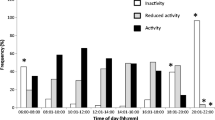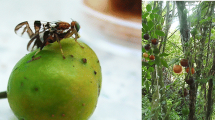Abstract
Field studies showed that male Rhagoletis juglandis and R. boycei flies guard egg-laying punctures (and the eggs within) on host walnut (Juglans major) fruit and defend those sites from conspecific and heterospecific males. In field experiments with artificially punctured fruit,as well as field observations on unmanipulated fruit, males were consistently more likely to be sighted and stayed longer on damaged fruit than on undamaged fruit. On artificially punctured fruit, they consistently spent more time in the vicinity of a puncture than expected by chance alone. Males together on damaged fruit were more likely to engage in contests over those fruit than males together on undamaged fruit. Copulations were consistently more frequent for either species on damaged than undamaged fruit, both in observations of unmanipulated fruit and in artificial puncture experiments. Analyses which controlled for the longer male residence time on damaged fruit suggested strongly that copulations were consistently achieved at higher per capita rates on damaged than on undamaged fruit, indicating that puncture-guarding functions to increase access to females. An exception to the pattern in male mating success was noted at a site where both species used host fruit on the same trees. In this case, R. juglandis males were only slightly more common on punctured fruit than on control fruit and male success in copulation did not differ significantly between the two types of fruit. This anomalous result was apparently due to an almost absolute advantage enjoyed by R. boycei males in on-fruit contests with R. juglandis males. A likely basis for improvements in mating success associated with puncture guarding was a propensity for females to deposit eggs into existing punctures. Both in observations of unmanipulated fruit and in artificial puncture experiments, females consistently attempted oviposition more often in damaged than undamaged fruit. In artificial puncture experiments, both species at both sites deposited most clutches in damaged fruit. Mating generally took place as females initiated oviposition. The possible functions of puncture use by females as well as alternative functions of puncture guarding by males are discussed.
Similar content being viewed by others
References
Alcock J (1987) The effects of experimental manipulation of resources on the behavior of two calopterygid damselflies that exhibit resource-defense polygyny. Can J Zool 65:2475–2482
Averill AL, Prokopy RJ (1982a) Oviposition-deterring fruit marking pheromone in Rhagoletis basiola. Fla Entomol 64:221–226
Averill AL, Prokopy RJ (1982b) Oviposition-deterring fruit marking pheromone in Rhagoletis zephyria. J G Entomol Soc 17:315–319
Averill AL, Prokopy RJ (1987) Intraspecific competition in the tephritid fruit fly, Rhagoletis pomonella, Ecology 68:878–886
Averill AL, Prokopy RJ (1989) Host-marking pheromones. In: Robinson AS, Hooper G (eds) World crop pests, vol 3A. Fruit flies, their biology, natural enemies and control. Elsevier, Amsterdam, pp 207–219
Back EA, Pemberton CE (1915) Susceptibility of citrous fruits to the attack of the Mediterranean fruit fly. J Agric Res 3:311–330
Borgia G (1982) Experimental changes in resource structure and male density: size related differences in mating success among male Scatophaga stercoraria. Evolution 36:307–315
Boyce AM (1934) Bionomics of the walnut husk fly, Rhagoletis completa. Hilgardia 8:363–579
Brooks FE (1921) Walnut husk-maggot. US Dept Agric Bull 992:18
Bush GL (1966) The taxonomy, cytology and evolution of the genus Rhagoletis in North America. Bull Mus Comp Zool Harvard Univ 134:431–562
Cresson ET (1929) A revision of the North American species of fruit flies of the genus Rhagoletis (Diptera: Trypetidae). Trans Am Entomol Soc 55:401–414
Greenfield MD, Shelly TE, Downum KR (1987) Variation in host-plant quality: implications for territoriality in a desert grasshopper. Ecology 68:28–838
Greenfield MD, Shelly TE, Gonzalez-Coloma A (1989) Territory selection in a desert grasshopper: the maximization of conversion efficiency on a chemically defended shrub. J Anim Ecol 58:761–771
Jaenike J (1992) Host specialization in phytophagous insects. Annu Rev Ecol Syst 21:243–273
Lalonde RG, Mangel M Seasonal effects on superparasitism by Rhagoletis completa. J Anim Ecol, in press
Lenteren JC van (1981) Host discrimination in parasitoids. In: Nordlund DA, Jones RL, Lewis WJ (eds) Semiochemicals, their role in pest control. Wiley, New York, pp 153–179
Miller RG (1981) Simultaneous statistical inference. Springer, New York
Opp SB, Ziegner J, Bui N, Prokopy RJ (1990) Factors influencing estimates of sperm competition in Rhagoletis pomonella (Walsh) (Diptera: Tephritidae) Ann Entomol Soc Am 83:521–526
Papaj DR (1993) Use and avoidance of occupied hosts as a dynamic process in tephritid flies. In: Bernays E (ed) CRC handbook on insect-plant interactions, vol 5. CRC Press, New York, pp 25–46
Papaj DR, Hendrichs J, Katsoyannos BI (1989) Use of fruit wounds in oviposition by the Mediterranean fruit fly. Entomol Exp Appl 53:03–209
Papaj DR, Averill AL, Prokopy RJ, Wong TTY (1992) Host-marking pheromone and use of previously established oviposition sites by the Mediterranean fruit fly (Diptera: Tephritidae). J Insect Behav 5:583–598
Price PW (1970) Biology of and host exploitation by Pleolophus indistinctus (Hymenoptera: Ichneumonidae). Ann Entomol Soc Am 63:1502–1509
Prokopy RJ (1972) Evidence for a pheromone deterring repeated oviposition in apple maggot flies. Environ Entomol 1:326–332
Prokopy RJ (1975) Oviposition-deterring fruit marking pheromone in Rhagoletis fausta. Environ Entomol 4:298–300
Prokopy RJ (1976) Feeding, mating and oviposition activities of Rhagoletis fausta flies in nature. Ann Entomol Soc Am 69:899–904
Prokopy RJ (1981) Epideictic pheromones that influence spacing in patterns of phytophagous insects. In: Nordlund DA, Jones RL, Lewis WJ (eds) Semiochemicals, their role in pest control. Wiley, New York, pp 181–213
Prokopy RJ, Bush GL (1973) Mating behavior of Rhagoletis pomonella (Diptera: Tephritidae) IV Courtship. Can Entomol 105:873–891
Prokopy RJ, Bennett EW, Bush GL (1971) Mating behavior in Rhagoletis pomonella (Diptera: Tephritidae). Can Entomol 103:1405–1409
Prokopy RJ, Reissig WH, Moericke V (1976) Marking pheromones deterring repeated oviposition in Rhagoletis flies. Entomol Exp Appl 20:170–178
Shelly TE, Greenfield MD (1991) Dominions and desert clickers (Orthoptera: Acrididae): influences of resources and male signaling on female settlement patterns. Behav Ecol Sociobiol 28:133–140
Silvestri F (1914) Report of an expedition to Africa in search of the natural enemies of fruit flies (Trypaneidae), with descriptions, observations and biological notes. Hawaii Bd Agric For Div Entomol Bull 3
Singer MC, Vasco D, Parmesan C, Thomas CD, Ng D (1992) Distinguishing between ‘preference’ and ‘motivation’ in food choice: an example from insect oviposition. Anim Behav 44:463–471
Sivinski J, Burk T (1989) Behaviour: Reproductive and mating behavior. In: Robinson AS, Hooper G (eds) World crop pests, vol 3A. Fruit flies, their biology, natural enemies and control. Elsevier, Amsterdam, pp 343–351
Smith DC, Prokopy RJ (1981) Mating behavior of Rhagoletis mendax (Diptera: Tephritidae) flies in nature. Ann Entomol Soc Am 74:462–466
Smith RL, Larsen E (1993) Egg attendance and brooding by males of the giant water bug Lethocerus medius (Guerin) in the field (Heteroptera: Belostomatidae). J Insect Behav 6:93–106
Sokal RR, Rohlf FJ (1981) Biometry. Freeman, San Francisco
Thornhill R, Alcock J (1983) The evolution of insect mating systems. Harvard University Press, Cambridge
Waage JK (1973) Reproductive behavior and its relation to territoriality in Calopteryx maculata (Beauvois) (Odonata: Calopterygidae). Behaviour 47:240–256
Waage JK (1987) Choice and utilization of oviposition sites by the damselfly, Calopteryx maculata (Odonata: Calopterygidae). I. Influence of site size and the presence of other females. Behav Ecol Sociobiol 20:439–466
Whittingham LA, Taylor PD, Robertson RJ (1992) Confidence of paternity and paternal care. Am Nat 139:1115–1125
Xia X (1992) Uncertainty of paternity can select against paternal care. Am Nat 139:1126–1129
Zeh DW, Smith RL (1985) Paternal investment by terrestrial arthropods. Am Zool 25:785–805
Author information
Authors and Affiliations
Rights and permissions
About this article
Cite this article
Papaj, D.R. Oviposition site guarding by male walnut flies and its possible consequences for mating success. Behav Ecol Sociobiol 34, 187–195 (1994). https://doi.org/10.1007/BF00167743
Received:
Accepted:
Issue Date:
DOI: https://doi.org/10.1007/BF00167743




